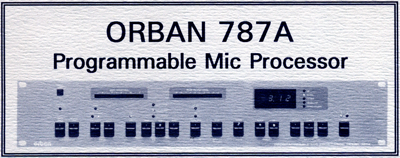If you haven't used a programmable mic processor in production, you don't know what you're missing. There are only a few of these boxes on the market, and the Orban 787A has got to be one of the better ones. What do you get? You get a three-band parametric equalizer, a gated compressor, a de-esser, and a noise gate in one easy to use unit. The designers had both the control room and the production room in mind. There are 99 user-programmable presets, so you can store mic settings for every jock on staff with a few slots left over for your local high school football team. The 787A is a mono processor with an optional second channel slave unit to expand to stereo.
The long row of seventeen buttons on the panel is a little intimidating at first, but once you dive in, programming the 787A is very easy; and the time invested setting it up is returned with interest. After setup, the only buttons you'll touch regularly are the UP and DOWN buttons which select a preset or change the value of a parameter, and the STORE and RECALL buttons which perform the memory functions. Two bargraphs on the panel give all the metering necessary with gain reduction on one and output level on the other. A red LED display shows all the other information needed.
The EQ section has four buttons: LOW, MID, and HIGH plus a bypass switch. Three LED's above these buttons indicate which mode the EQ is in: BOOST/CUT, BAND¬WIDTH, or CENTER FREQUENCY. To adjust the highs, for example, you would press HIGH. One of the LED's will light up to indicate the current EQ mode. Pressing HIGH repeatedly alternates between the three modes. Once BOOST/CUT, BANDWIDTH, or CENTER FREQUENCY is selected, the current value is displayed in the LED readout. Adjustment is then made with the UP and DOWN buttons. Fine and course adjustments are available for precise settings.
Continuing our tour of "what the buttons do," we come to the compressor section of the panel. It offers three more buttons to play with: INPUT ATTEN, RELEASE TIME, and GATE THRESHOLD. To increase gain reduction, you simply hit INPUT ATTEN then hit the UP button until the desired amount of gain reduction is indicated on the bargraph. RELEASE TIME is indicated on the LED display in dB's per second. Again, UP and DOWN are used to make the adjustments. The GATE THRESHOLD is just as easily adjusted. With all three parameters set properly, this compressor sounds very good. It delivers that "punch" if you want it, or very smooth and subtle control over input levels. While the 787A is made by the same people that make the popular ORBAN 424 compressor/limiter, the sound is very different. Without getting into the nuts and bolts of compressors, let's just say that the 424 is a great compressor for your transmitter audio chain, and the 787A is definitely the one for the mic. Cranked to the max, the output of the compressor sounds very clean (if you can consider totally obliterated dynamic range clean -- not too many engineers can), and the gate does a great job of keeping the compressor from "rushing up" during pauses.
The de-esser attenuates highs when peaks above 6kHz exceed the adjustable threshold level. It's a handy tool for those of us who might get carried away with the high frequency boost of the EQ section. The de-esser can also be bypassed.
The NOISE GATE is an even handier tool. Its threshold is also adjustable, but it uses the same threshold as the compressor gate. This didn't appear to cause any problems in all the settings tested for this review. The noise gate on the 787A is a nice feature for production, especially if your mic is in the same room as your equipment. With the proper threshold setting, room noise is virtually eliminated on voice tracks.

